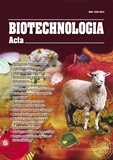ISSN 2410-7751 (Print)
ISSN 2410-776X (Online)

Biotechnologia Acta Т. 18, No. 3, 2025
P. 65-68, Bibliography 9 , Engl.
UDC 661.8…782:579.873.6
doi:https://doi.org/10.15407/biotech18.03.065
STREPTOMYCETE PLASMIDS CONTAINING BIOSYNTHESIS GENE CLUSTERS OF ANTITUMOR ANTIBIOTIC LIDAMICIN
L.V. Polishchuk
Zabolotny Institute of Microbiology and Virology of of the National Academy of Sciences of Ukraine, Kyiv
Anticancer antibiotic lidamycin is produced by Streptomyces globisporus C-1027 strain. The lidamycin biosynthesis cluster (LDM-cluster) is localized on its plasmid SGLP1.
Aim. To identify and characterize plasmid-localized gene clusters potentially involved in lidamycin biosynthesis in streptomycetes.
Methods. Nucleotide sequences of streptomycetes from the Internet database Nucleotide Collection on the National Center for Biotechnology Information were objects of this study. Search for probable LDM clusters was performed using the Basic Local Alignment Search Tool. The LDM-cluster sequence of S. globisporus C-1027 was used as a query in BLASTN analysis.
Results. The database contains information on the primary structures of thousands of chromosomes and dozens of plasmids of streptomycetes, which are fully defined (Compete genome). BLASTN-analysis of primary structures of DNAs revealed the presence of probable LDM clusters in 6 streptomycete plasmids. Nucleotide sequences of 7 plasmids were only partially identical – they all contained sequences that were similar to the fragment 7,747 bp – 112,237 bp of SGLP1.
Conclusions. The findings have demonstrated that LDM clusters are predominantly localized on plasmids in Streptomyces species. Although the identified plasmids share substantial sequence similarity - spanning approximately 104.5 kb - with the reference SGLP1 plasmid, they are not genetically identical.
Keywords: Streptomyces, cluster, plasmid, nucleotide sequence, computerized analysis, lidamycin biosynthesis.
© Palladin Institute of Biochemistry of the National Academy of Sciences of Ukraine, 2025
References
- Shao, R. G., & Zhen, Y. S. (2008). Enediyne anticancer antibiotic lidamycin: chemistry, biology and pharmacology. Anti-cancer agents in medicinal chemistry, 8(2), 123–131. https://doi.org/10.2174/187152008783497055
- Shi, Y. K., Wu, S. Y., Huang, Y. H., Zhen, Y. S. (2006) Chemosensitivity of mdr1 gene overexpressed multidrug resistant cancer cells to lidamycin. Acta Pharmaceutica Sinica, 41(12), 1146-1151.
- Chen, Y., Sun, W., He, R., Zhang, F., Wang, H., Li, P., Shao, R. G., & Xu, X. (2017). Lidamycin decreases CD133 expression in hepatocellular carcinoma via the Notch signaling pathway. Oncology letters, 14(6), 7889–7895. https://doi.org/10.3892/ol.2017.7248
- Liu, W., Christenson, S. D., Standage, S., & Shen, B. (2002). Biosynthesis of the enediyne antitumor antibiotic C-1027. Science (New York, N.Y.), 297(5584), 1170–1173. https://doi.org/10.1126/science.1072110
- Li, X., Lei, X., Zhang, C., Jiang, Z., Shi, Y., Wang, S., Wang, L., Hong, B. (2016) Complete genome sequence of Streptomyces globisporus C-1027, the producer of an enediyne antibiotic lidamycin. Journal of biotechnology, 222, 9–10. https://doi.org/10.1016/j.jbiotec.2016.02.004
- Li, M., Liu, W., & Li, Y. (2003). Cloning, expression and characterization of gene sgcD involved in the biosynthesis of novel antitumor lidamycin. Science in China. Series C, Life sciences, 46(3), 310–319. https://doi.org/10.1360/03yc9033
- Mao, D., Okada, B. K., Wu, Y., Xu, F., Seyedsayamdost, M. R. (2018) Recent advances in activating silent biosynthetic gene clusters in bacteria. Current opinion in microbiology, 45, 156–163. https://doi.org/10.1016/j.mib.2018.05.001
- Yamasaki, M., Ikuto, Y., Ohira, A., Chater, K., & Kinashi, H. (2003). Limited regions of homology between linear and circular plasmids encoding methylenomycin biosynthesis in two independently isolated streptomycetes. Microbiology (Reading, England), 149(Pt 5), 1351–1356. https://doi.org/10.1099/mic.0.26102-0
- Kinashi, H., & Shimaji, M. (1987). Detection of giant linear plasmids in antibiotic producing strains of Streptomyces by the OFAGE technique. The Journal of antibiotics, 40(6), 913–916. https://doi.org/10.7164/antibiotics.40.913
- Yamasaki, M., Redenbach, M., Kinashi, H. (2001) Integrated structures of the linear plasmid SCP1 in two bidirectional donor strains of Streptomyces coelicolor A3(2). Molecular and General Genetics, 2001, 264, 634–642. https://doi.org/10.1007/s004380000349
- Cho, G., & Kwak, Y. S. (2019). Evolution of Antibiotic Synthesis Gene Clusters in the Streptomyces globisporusTFH56, Isolated from Tomato Flower. G3 (Bethesda, Md.), 9(6), 1807–1813. https://doi.org/10.1534/g3.119.400037

